The Power and Efficiency Analyses of the Cylindrical Cavity Receiver on the Solar Stirling Engine
Abstract
:1. Introduction
2. A Heat-Pipe Receiver
- (1)
- Radiation loss
- (2)
- Convection thermal loss
- (3)
- Conduction heat loss
3. The Absorber Cavity Model’s Thermal Performance
3.1. Cavity Absorbing Model
3.2. Simulation Method
3.3. Model Validation
3.4. Cavity Wall Temperature’s Effect on Thermal Performance
3.5. Heat Absorbing Inclination Angle’s Effect on Thermal Performance
3.6. Effect of Open Area Ratio on Thermal Performance
- As the absorber wall surface temperature increased, both cavity natural convection heat loss and radiation heat loss increased. The wall temperature was 700, 800, 900, and 1000 K at 0° inclination angle, and the radiation heat loss to the total heat loss ratio was 74.16%, 76.64%, 78.78%, and 80.72%, respectively. The ratio of natural heat loss was small.
- With the angle increased, the overall heat loss of the convection was reduced. At 900 K wall temperature, the inclination angle was 0°, 30°, 60°, and 90°, and the convection heat loss to the total heat loss ratio was 21.22%, 14.19%, 13.25%, and 9.29%, respectively. If the inclination angle was large, the natural convection heat sink can be suppressed.
- As the opening ratio decreased, the cavity receiver natural convection heat loss and radiant heat loss were reduced, and the opening ratio had a greater impact on the radiation heat loss, as well as on the total heat loss. The optimized setting of the opening ratio parameter is meaningful to reduce the heat absorber heat loss and improve the thermal performance. Based on the findings of the cavity receiver internal temperature distribution characteristics and its heat loss characteristics, structure optimization was an effective way to improve the dish solar Stirling thermal power and efficiency.
4. Stirling Engine’s Output and Efficiency
4.1. Wall Temperature Effect on Stirling Engine’s Power and Efficiency
4.2. Incline Angle Effect on Stirling Engine’s Output and Efficiency
4.3. Open Area Ratio Effect on Stirling Engine’s Output and Efficiency
5. Results
- Cavity receiver thermal performance
- (1)
- The cavity receiver temperature field distribution under different wall conditions is similar. Cold air enters from the bottom of the receiver. After being heated by the wall, it flows upward along the inner wall and finally flows out from the upper area of the heat absorber opening.
- (2)
- The higher the wall temperature, the greater the proportion of radiant heat loss, and the radiant heat loss increasing rate is significantly greater than the natural convection heat loss. The greater the wall emissivity, the more obvious the effect of radiant heat transfer and the greater the value of radiant heat loss, but the wall emissivity has no influence on natural convection heat transfer.
- (3)
- The cavity receiver heat loss decreases as the tilt angle increases. Simultaneously, the high temperature stagnation zone in the receiver cavity increases, and the convective heat transfer with the outside decreases. The greater the inclination angle, the lower the natural convection heat loss, and the value of radiant heat loss has nothing to do with the inclination angle.
- Stirling engine’s power and efficiencyResults show that as the absorber wall temperature increases, both the engine output power and efficiency increase.
- (1)
- When the absorber wall temperature changes from 700 to 1000 K, the efficiency of the engine has increased by 8.8% from 21.34% to 30.11%. The higher the temperature, the higher the efficiency.
- (2)
- As the absorber inclination angle increases, the engine output and efficiency increase. The engine efficiency increased by 7.7% from 21.1% to 28.8% when the tilt angle of the absorber changed from 0° to 60°.
- (3)
- With the increase in the aperture ratio, the engine output and efficiency reduced, and the engine efficiency at the aperture ratio of 0.5 was 4% larger than that at the aperture ratio of 1.
Author Contributions
Funding
Conflicts of Interest
Nomenclature
| internal cavity area | |
| solar receiver area | |
| area of the concentrator, ( | |
| cavity receiver inner diameter, (cm) | |
| aperture diameter, cm | |
| absorbed solar radiation (W) | |
| total heat loss (W) | |
| total input thermal power of Stirling engine | |
| heat loss from the conduction (W) | |
| heat loss from the convection (W) | |
| heat loss from the radiation (W) | |
| cavity receiver wall temperature (K) | |
| ambient temperature (K) | |
| temperature of the cavity receiver (K) | |
| Re | Reynolds number |
| the Nusselt number | |
| the Grashof number | |
| thermal conductivity ( | |
| convective heat transfer coefficient of the cavity receiver ( | |
| radiation heat transfer coefficient of the cavity receiver ( | |
| conduction heat transfer coefficient from the cavity receiver to ambient ( | |
| Incident solar flux intensity | |
| specific heat at constant pressure ( | |
| t | time (s) |
| the global coefficient of heat loss (, | |
| the geometric concentration ratio. | |
| Power output (W) | |
| length of the cavity (m) | |
| diameter of interior cavity | |
| Greek symbols | |
| the Stefan–Boltzmann constant. | |
| the emissivity of solar receiver | |
| the heat emissivity of receiver wall material ( = 0.8). | |
| the collector optical efficiency ( | |
| the day angle (radians), the average value of is 3.14. | |
| the cavity inclination ranging between 0 and | |
| air heat conduction coefficient ( | |
References
- Shaulsky, E.; Boo, C.; Lin, S.; Elimelech, M. Membrane-Based Osmotic Heat Engine with Organic Solvent for Enhanced Power Generation from Low-Grade Heat. Environ. Sci. Technol. 2015, 49, 5820–5827. [Google Scholar] [CrossRef] [PubMed]
- Hafez, A.; Attia, A.; Eltwab, H.; Elkousy, A.; Afifi, A.; Abdelhamid, A.; Abdelqader, A.; Fateen, S.-E.; El-Metwally, K.; Soliman, A.; et al. Design analysis of solar parabolic trough thermal collectors. Renew. Sustain. Energy Rev. 2018, 82, 1215–1260. [Google Scholar] [CrossRef]
- Qandil, H.; Wang, S.; Zhao, W. Application-based design of the Fresnel lens solar concentrator. Renew. Wind Water Sol. 2019, 6, 3. [Google Scholar] [CrossRef]
- Barlev, D.; Vidu, R.; Stroeve, P. Innovation in concentrated solar power. Sol. Energy Mater. Sol. Cells 2011, 95, 2703–2725. [Google Scholar] [CrossRef]
- Wu, S.-Y.; Xiao, L.; Cao, Y.; Li, Y.-R. Convection heat loss from cavity receiver in parabolic dish solar thermal power system: A review. Sol. Energy 2010, 84, 1342–1355. [Google Scholar] [CrossRef]
- Mancini, T.; Heller, P.; Butler, B.; Osborn, B.; Schiel, W.; Goldberg, V.; Buck, R.; Diver, R.; Andraka, C.; Moreno, J. Dish-Stirling Systems: An Overview of Development and Status. J. Sol. Energy Eng. 2003, 125, 135–151. [Google Scholar] [CrossRef]
- Wu, Z.; Dai, W.; Man, M.; Luo, E. A solar-powered traveling-wave thermoacoustic electricity generator. Sol. Energy 2012, 86, 2376–2382. [Google Scholar] [CrossRef]
- Zhu, S.; Yu, G.; Ma, Y.; Cheng, Y.; Wang, Y.; Yu, S.; Wu, Z.; Dai, W.; Luo, E. A free-piston Stirling generator integrated with a parabolic trough collector for thermal-to-electric conversion of solar energy. Appl. Energy 2019, 242, 1248–1258. [Google Scholar] [CrossRef]
- AVING Special Report on Solar Power International; CA, USA, 2010; Available online: http://kr.aving.net/news/view.php?articleId=172098 (accessed on 5 November 2020).
- Hussain, T.; Islam, M.; Kubo, I.; Watanabe, T. Study of heat transfer through a cavity receiver for a solar powered advanced Stirling engine generator. Appl. Therm. Eng. 2016, 104, 751–757. [Google Scholar] [CrossRef]
- Cheng, C.-H.; Chen, Y.-F. Numerical simulation of thermal and flow fields inside a 1-kW beta-type Stirling engine. Appl. Therm. Eng. 2017, 121, 554–561. [Google Scholar] [CrossRef]
- Lai, X.; Long, R.; Zhi-Chun, L.; Liu, W. Stirling engine powered reverse osmosis for brackish water desalination to utilize moderate temperature heat. Energy 2018, 165, 916–930. [Google Scholar] [CrossRef]
- Hafez, A.; Soliman, A.; El-Metwally, K.; Ismail, I. Design analysis factors and specifications of solar dish technologies for different systems and applications. Renew. Sustain. Energy Rev. 2017, 67, 1019–1036. [Google Scholar] [CrossRef]
- Schiel, W.; Keck, T. Parabolic dish concentrating solar power (CSP) systems. In Concentrating Solar Power Technology: Principles, Developments and Applications; Lovegrove, K., Stein, W., Eds.; Woodhead Publishing: Cambridge, UK, 2012; pp. 284–322. [Google Scholar]
- Caballero, G.E.C.; Mendoza, L.S.; Martinez, A.M.; Silva, E.E.; Melian, V.R.; Venturini, O.J.; Del Olmo, O.A. Optimization of a Dish Stirling system working with DIR-type receiver using multi-objective techniques. Appl. Energy 2017, 204, 271–286. [Google Scholar] [CrossRef]
- Natarajan, S.K.; Reddy, K.; Mallick, T.K. Heat loss characteristics of trapezoidal cavity receiver for solar linear concentrating system. Appl. Energy 2012, 93, 523–531. [Google Scholar] [CrossRef]
- Wu, S.-Y.; Xiao, L.; Cao, Y.; Li, Y.-R. A parabolic dish/AMTEC solar thermal power system and its performance evaluation. Appl. Energy 2010, 87, 452–462. [Google Scholar] [CrossRef]
- Nepveu, F.; Ferrière, A.; Bataille, F. Thermal model of a dish/Stirling systems. Sol. Energy 2009, 83, 81–89. [Google Scholar] [CrossRef]
- Yaqi, L.; Yaling, H.; Weiwei, W. Optimization of solar-powered Stirling heat engine with finite-time thermodynamics. Renew. Energy 2011, 36, 421–427. [Google Scholar] [CrossRef]
- Xiao, L.; Wu, S.-Y.; Li, Y.-R. Numerical study on combined free-forced convection heat loss of solar cavity receiver under wind environments. Int. J. Therm. Sci. 2012, 60, 182–194. [Google Scholar] [CrossRef]
- Neber, M.; Lee, H. Design of a high temperature cavity receiver for residential scale concentrated solar power. Energy 2012, 47, 481–487. [Google Scholar] [CrossRef]
- Wang, F.; Lin, R.; Liu, B.; Tan, H.; Shuai, Y. Optical efficiency analysis of cylindrical cavity receiver with bottom surface convex. Sol. Energy 2013, 90, 195–204. [Google Scholar] [CrossRef]
- Wu, S.-Y.; Guo, F.-H.; Xiao, L. Numerical investigation on combined natural convection and radiation heat losses in one side open cylindrical cavity with constant heat flux. Int. J. Heat Mass Transf. 2014, 71, 573–584. [Google Scholar] [CrossRef]
- Sup, B.A.; Zainudin, M.F.; Ali, T.Z.S.; Abu Bakar, R.; Ming, G.L. Effect of Rim Angle to the Flux Distribution Diameter in Solar Parabolic Dish Collector. Energy Procedia 2015, 68, 45–52. [Google Scholar] [CrossRef] [Green Version]
- Ahmadi, M.H.; Mellit, A.; Pourfayaz, F.; Feidt, M. Thermodynamic analysis and multi objective optimization of performance of solar dish Stirling engine by the centrality of entransy and entropy generation. Int. J. Electr. Power Energy Syst. 2016, 78, 88–95. [Google Scholar] [CrossRef]
- Gholamalizadeh, E.; Chung, J.D. Design of the Collector of a Solar Dish-Stirling System: A Case Study. IEEE Access 2017, 5, 20754–20762. [Google Scholar] [CrossRef]
- Ruelas, J.; Velázquez, N.; Cerezo, J. A mathematical model to develop a Scheffler-type solar concentrator coupled with a Stirling engine. Appl. Energy 2013, 101, 253–260. [Google Scholar] [CrossRef]
- Li, S.; Xu, G.; Luo, X.; Quan, Y.; Ge, Y. Optical performance of a solar dish concentrator/receiver system: Influence of geometrical and surface properties of cavity receiver. Energy 2016, 113, 95–107. [Google Scholar] [CrossRef]
- Tan, Y.; Zhao, L.; Bao, J.; Liu, Q. Experimental investigation on heat loss of semi-spherical cavity receiver. Energy Convers. Manag. 2014, 87, 576–583. [Google Scholar] [CrossRef]
- Reddy, K.; Natarajan, S.K.; Veershetty, G. Experimental performance investigation of modified cavity receiver with fuzzy focal solar dish concentrator. Renew. Energy 2015, 74, 148–157. [Google Scholar] [CrossRef]
- Mao, Q.; Shuai, Y.; Yuan, Y. Study on radiation flux of the receiver with a parabolic solar concentrator system. Energy Convers. Manag. 2014, 84, 1–6. [Google Scholar] [CrossRef]
- Loni, R.; Kasaeian, A.; Asli-Ardeh, E.A.; Ghobadian, B.; Le Roux, W. Performance study of a solar-assisted organic Rankine cycle using a dish-mounted rectangular-cavity tubular solar receiver. Appl. Therm. Eng. 2016, 108, 1298–1309. [Google Scholar] [CrossRef]
- Gholamalizadeh, E.; Chung, J.D. Thermal Analysis of the Receiver of a Standalone Pilot Solar Dish–Stirling System. Entropy 2018, 20, 429. [Google Scholar] [CrossRef] [Green Version]
- Kadri, Y.; Abdallah, H.H. Performance evaluation of a stand-alone solar dish Stirling system for power generation suitable for off-grid rural electrification. Energy Convers. Manag. 2016, 129, 140–156. [Google Scholar] [CrossRef]
- Xie, W.; Dai, Y.; Wang, R. Numerical and experimental analysis of a point focus solar collector using high concentration imaging PMMA Fresnel lens. Energy Convers. Manag. 2011, 52, 2417–2426. [Google Scholar] [CrossRef]
- Mohammad, H.A.; Hoseyn, S.; Saeed, D.H.; Hadi, H. Esigning a solar powered Stirling heat engine based on multiple criteria: Maximized thermal efficiency and power. Energy Convers. Manag. 2013, 75, 282–291. [Google Scholar]
- Duffie, J.A.; Beckman, W.A.; Blair, N. Solar Engineering of Thermal Processes, 3rd ed.; John Willey & Sons Inc.: Madison, WI, USA, 2006. [Google Scholar]
- Reddy, K.; Kumar, N.S. Combined laminar natural convection and surface radiation heat transfer in a modified cavity receiver of solar parabolic dish. Int. J. Therm. Sci. 2008, 47, 1647–1657. [Google Scholar] [CrossRef]
- Kumar, N.S.; Reddy, K. Comparison of receivers for solar dish collector system. Energy Convers. Manag. 2008, 49, 812–819. [Google Scholar] [CrossRef]
- Dormael, V.J.P. Isothermic Calculation of a Stirling Engine: Alpha, Beta or Gamma. 2008. Available online: https://www.google.com.hk/search?ei=D0qiX8bGK43T-QaSspKwBA&q=Dormael%EF%BC%8CV+J%2C+P.+Isothermic+calculation+of+a+Stirling+engine%3A+alpha%2C+beta+or+gamma%EF%BC%8C2008 (accessed on 20 October 2020).
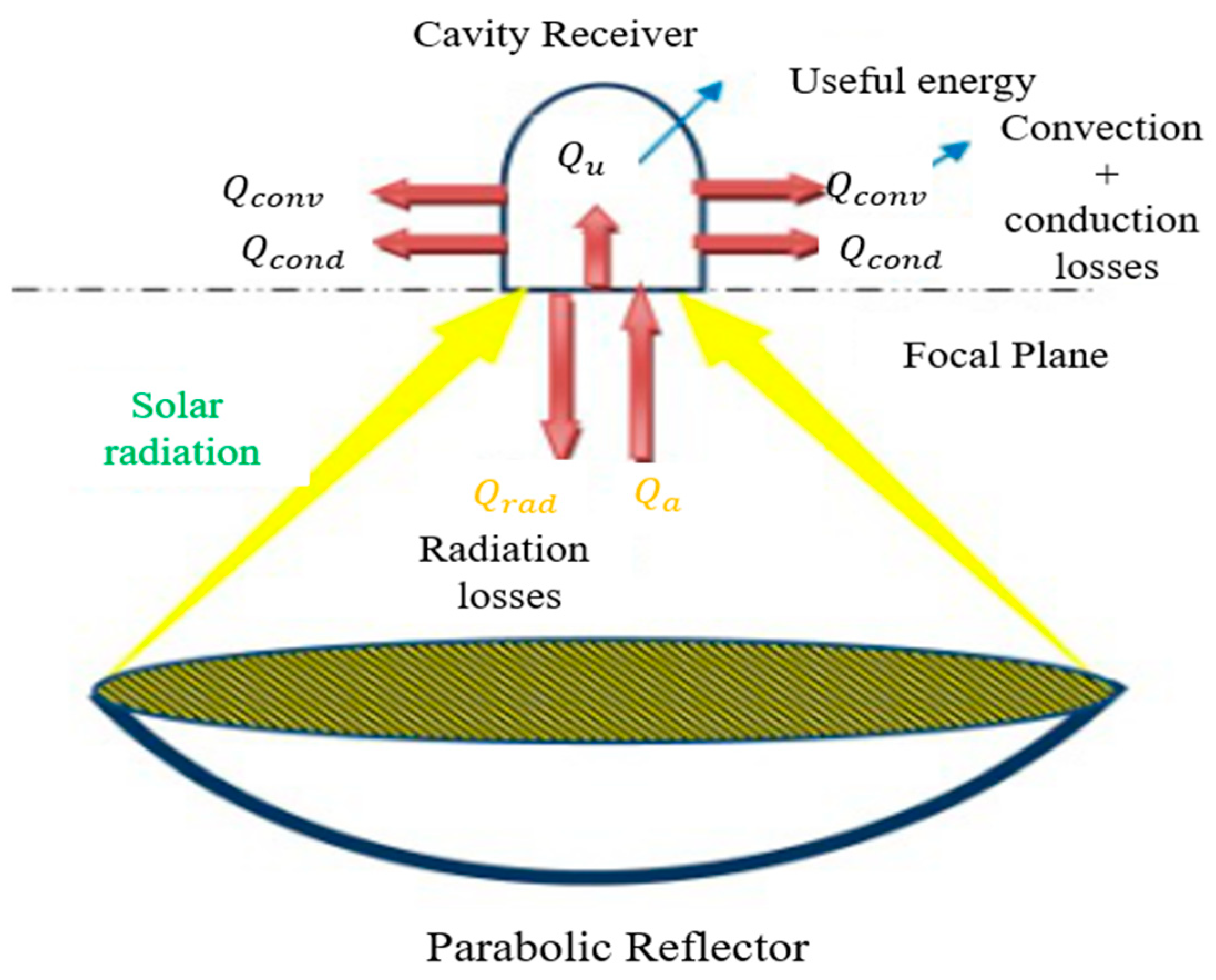
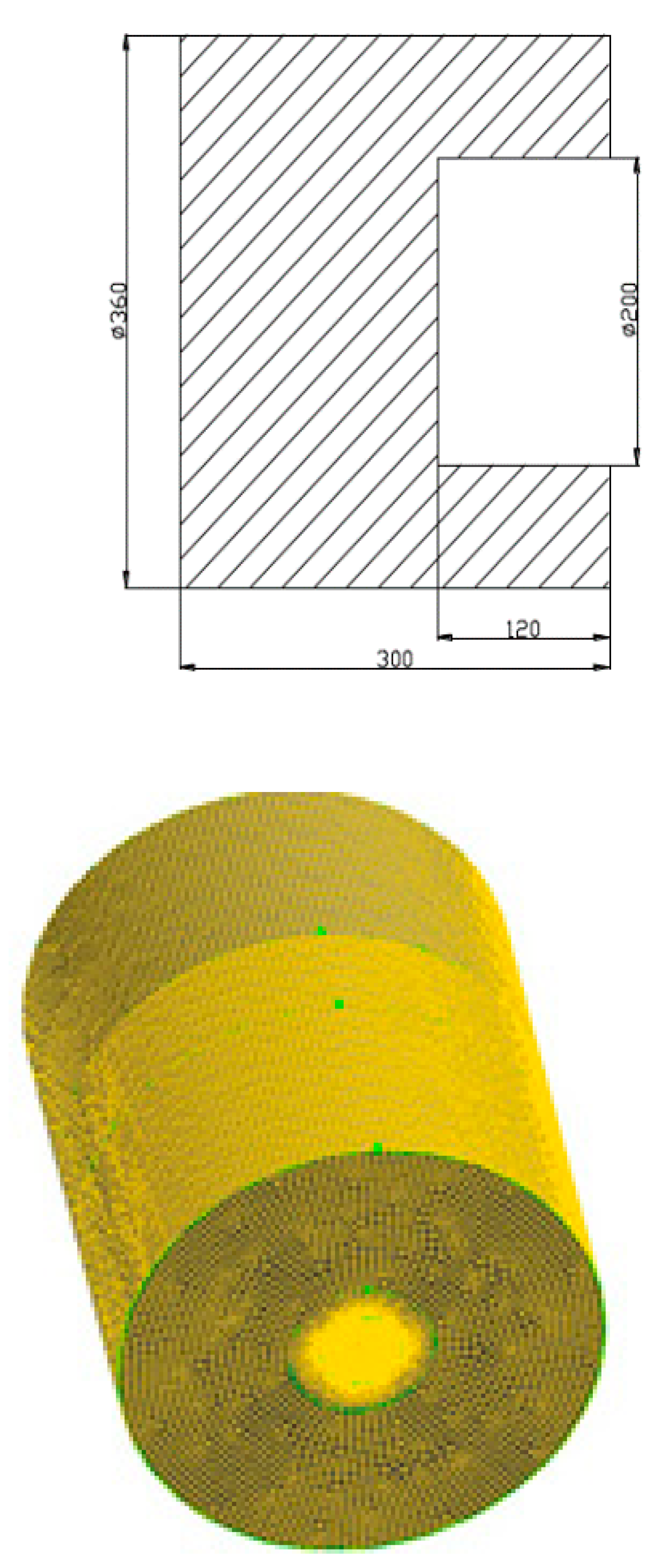
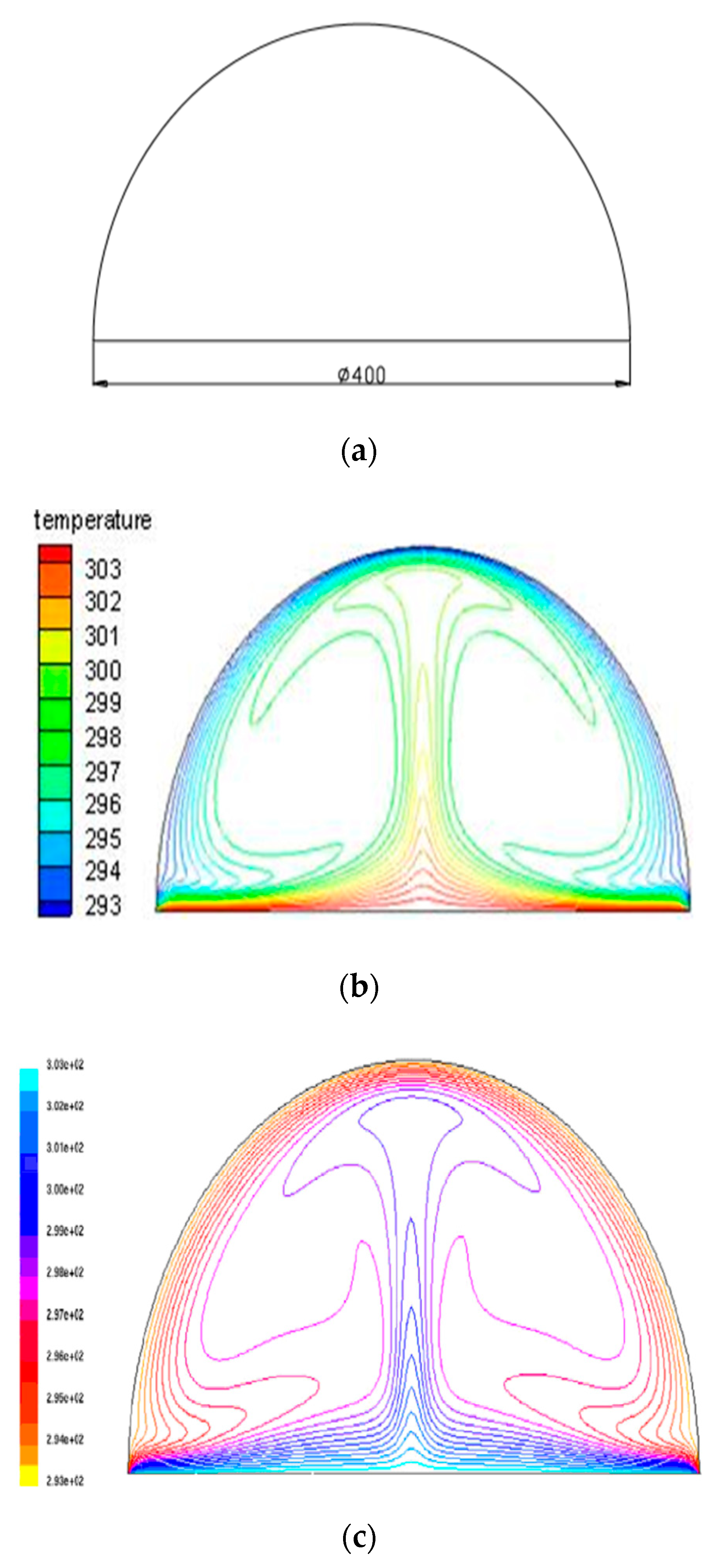

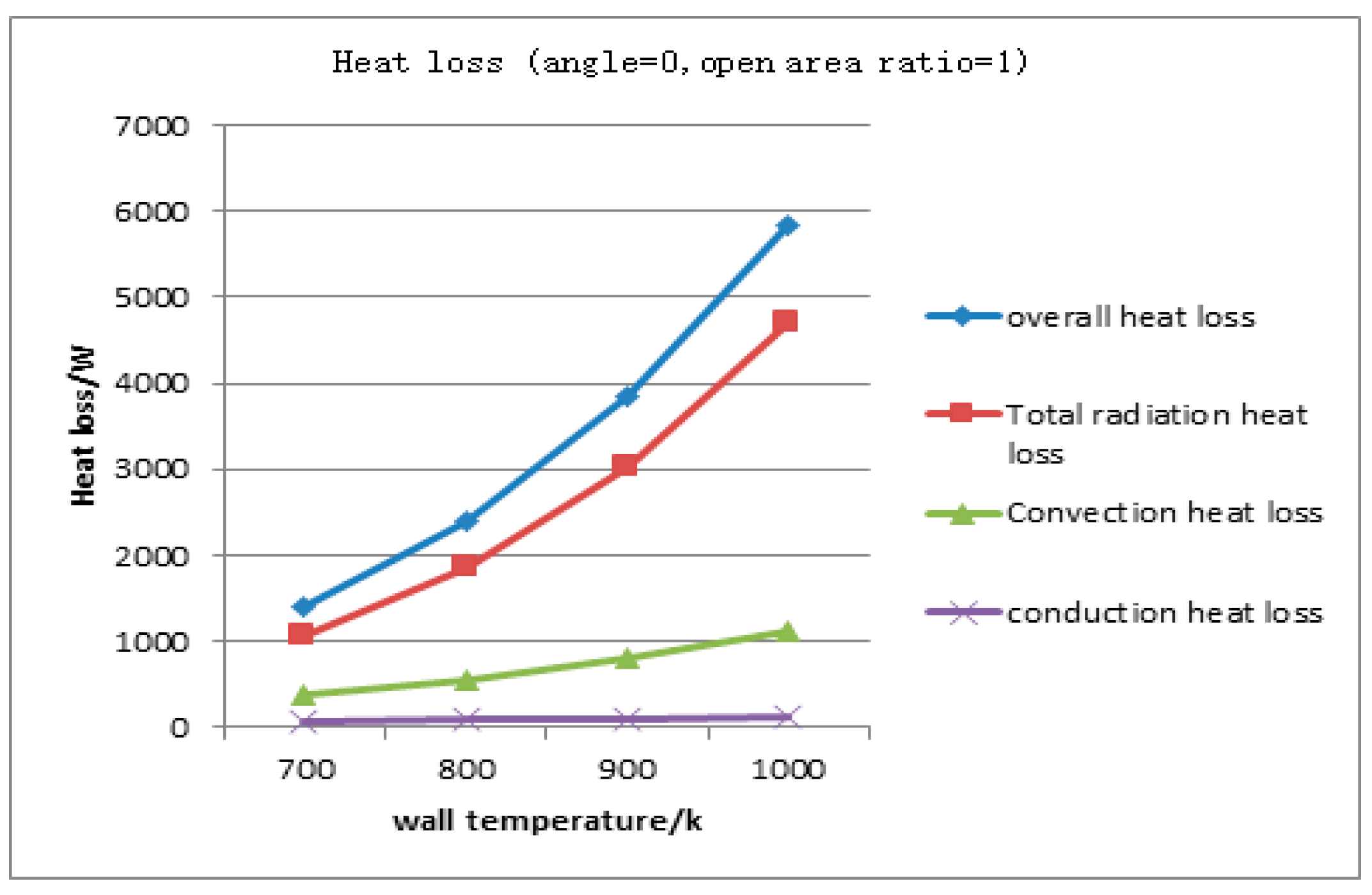

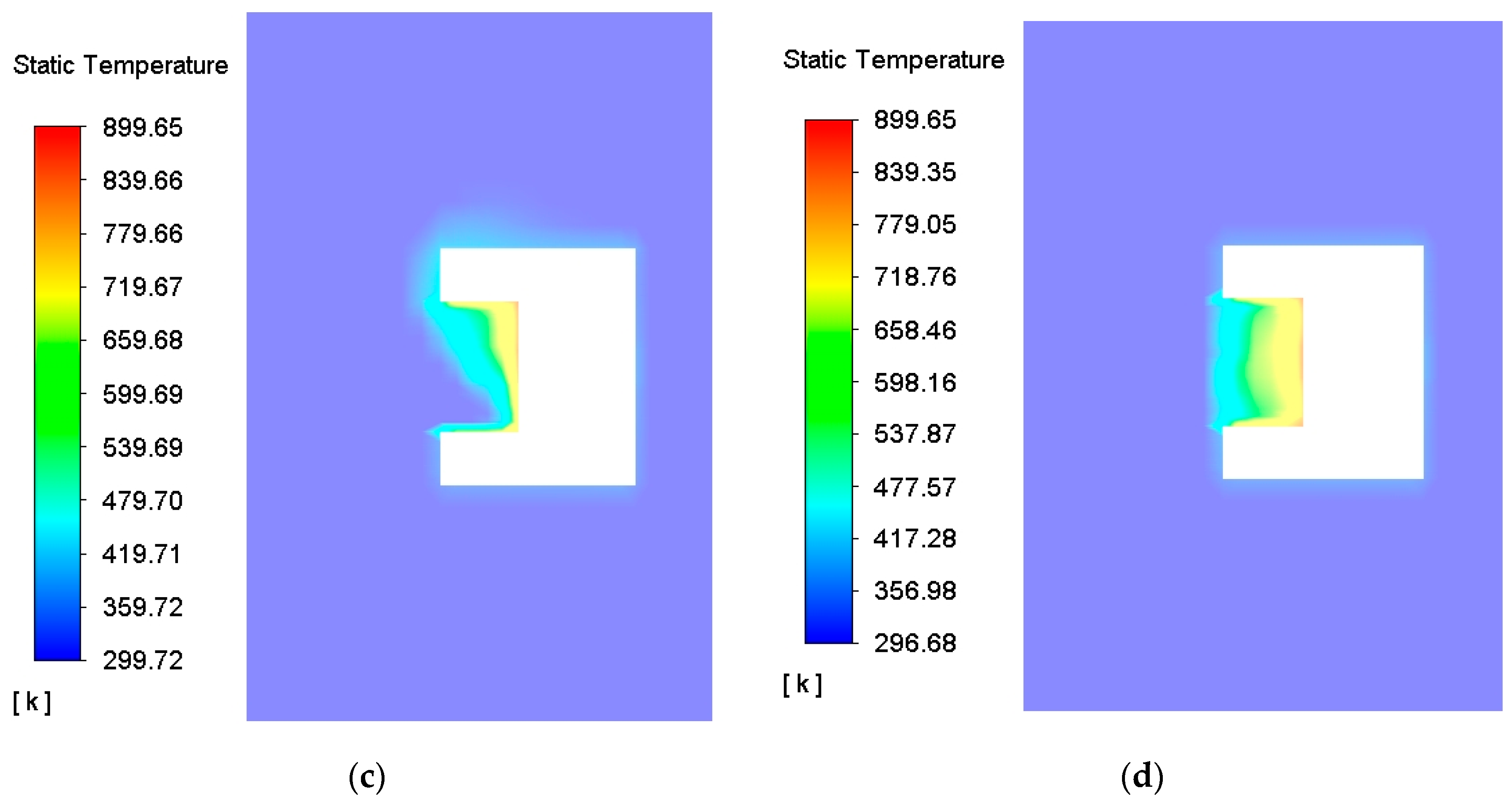

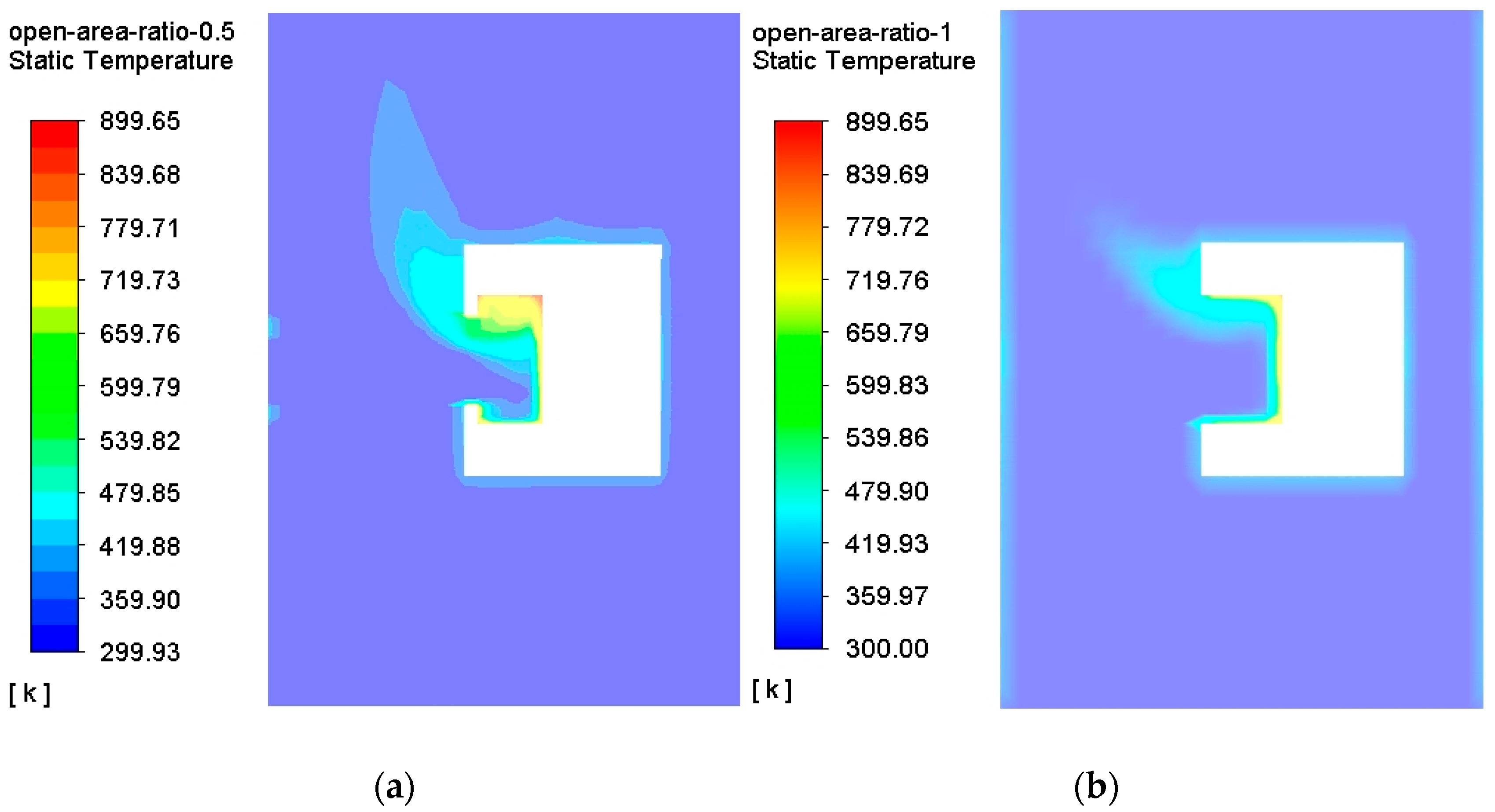
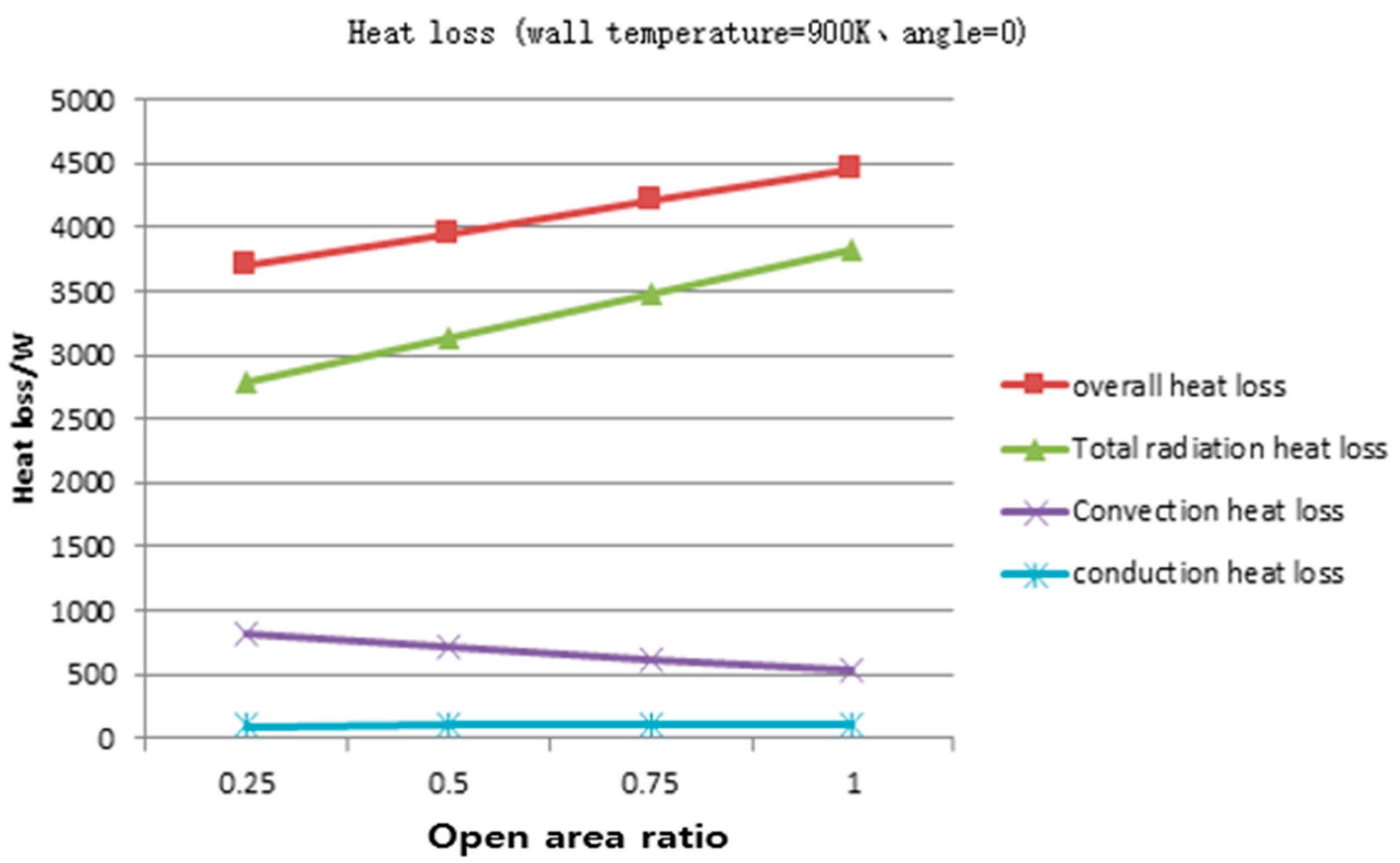


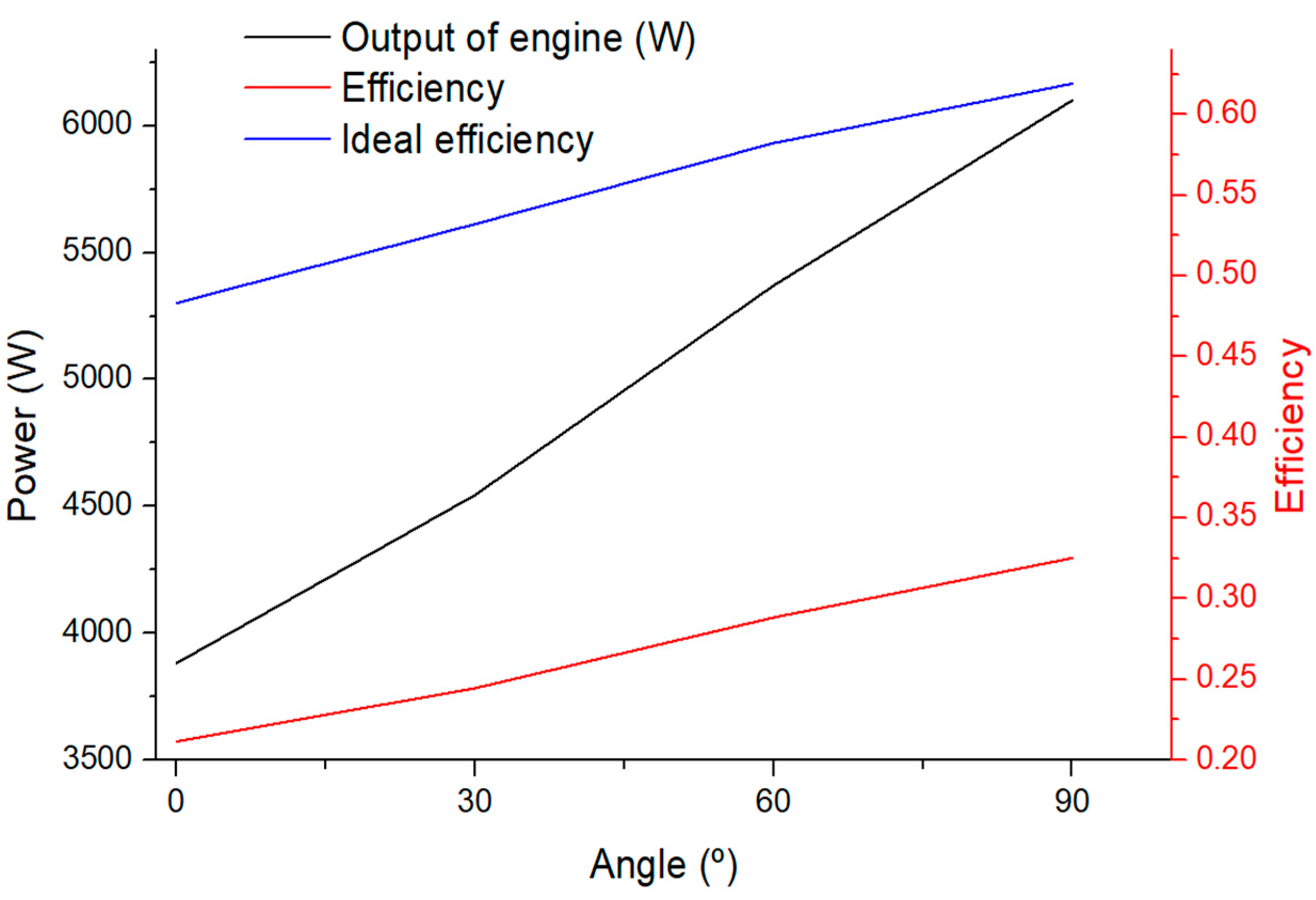
| 650 | 750 | 850 | 950 | |
| 135,454.4851 | 15,639.7905 | 17,725.0959 | 19,810.4013 | |
| 611 | 705 | 799 | 893 | |
| 378 | 401 | 470 | 524 | |
| 589 | 645 | 746 | 833 |
| Wall temperature (K) | 700 | 800 | 900 | 1000 |
| Average temperature (K) | 470 | 536 | 598 | 654 |
| (K) | 230 | 264 | 302 | 346 |
| 14,744.156 | 16,923.727 | 19,359.718 | 22,180.340 | |
| 1412.6106 | 2409.2582 | 3844.3599 | 5831.0192 | |
| 13,331.546 | 14,514.469 | 15,515.359 | 16,349.321 |
| Open Area Ratio | 0.25 | 0.5 | 0.75 | 1 |
|---|---|---|---|---|
| Temperature (K) | 715 | 675 | 638 | 598 |
| Input power (W) | 18,494.378 | 18,240.010 | 17,985.639 | 17,731.269 |
| Output of engine (W) | 5587.13 | 5152.52 | 4745.24 | 4299.62 |
| Efficiency | 0.302 | 0.282 | 0.264 | 0.242 |
| Ideal efficiency | 0.597 | 0.573 | 0.549 | 0.518 |
Publisher’s Note: MDPI stays neutral with regard to jurisdictional claims in published maps and institutional affiliations. |
© 2020 by the authors. Licensee MDPI, Basel, Switzerland. This article is an open access article distributed under the terms and conditions of the Creative Commons Attribution (CC BY) license (http://creativecommons.org/licenses/by/4.0/).
Share and Cite
Li, J.-Q.; Kwon, J.-T.; Jang, S.-J. The Power and Efficiency Analyses of the Cylindrical Cavity Receiver on the Solar Stirling Engine. Energies 2020, 13, 5798. https://doi.org/10.3390/en13215798
Li J-Q, Kwon J-T, Jang S-J. The Power and Efficiency Analyses of the Cylindrical Cavity Receiver on the Solar Stirling Engine. Energies. 2020; 13(21):5798. https://doi.org/10.3390/en13215798
Chicago/Turabian StyleLi, Ji-Qiang, Jeong-Tae Kwon, and Seon-Jun Jang. 2020. "The Power and Efficiency Analyses of the Cylindrical Cavity Receiver on the Solar Stirling Engine" Energies 13, no. 21: 5798. https://doi.org/10.3390/en13215798
APA StyleLi, J.-Q., Kwon, J.-T., & Jang, S.-J. (2020). The Power and Efficiency Analyses of the Cylindrical Cavity Receiver on the Solar Stirling Engine. Energies, 13(21), 5798. https://doi.org/10.3390/en13215798





